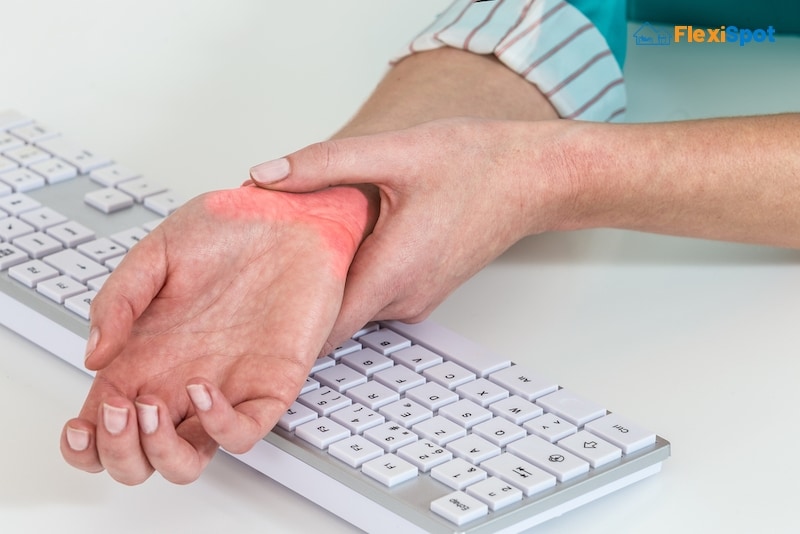Computer users use their hands and wrists all day long. For every action they wish to perform on their computer, they either have to use the mouse to move the cursor or type. If their shift is 8 hours long, they’re usually using their hands and wrists for, more or less, their entire shift. Imagine the level of stress on the muscles, tendons, and joints of hands and wrists. No wonder your hands hurt like crazy by the time you make it home.
There’s little a computer user can do to reduce the number of hours they’ve got to use their hands while at work. However, what they can do is do certain exercises and stretches that ensure that the muscles, joints, and tendons of the hands don’t get stiff and fatigued. This would then ensure that they don't experience pain.
If your job requires you to use the computer for long hours, you may already have started to feel the consequences of using your hands and wrists too much. The pain will get worse if you continue using your computer in an incorrect posture. One way to manage the posture and correct it is by using ergonomic office furniture like the Pro Plus Standing Desk (E7).
If the fear of your hand and wrist pain getting worse is stressing you out, you’ve come to the right place. We’ll talk about what can excessive computer usage means for your hands and wrists, how important exercise is, and which hand and wrist exercises are the best.
What Harm Can Overuse of Hands and Wrist Cause?
You may wonder what harm can overuse of hands and wrists at work cause except for pain. Moreover, pain can easily be managed with painkillers, right?
Wrong.
If a certain activity is causing pain, it’s a sign that something’s not right. If your job involves excessive use of hands and wrists like typing or working on machinery, it will probably cause you pain. This pain is a sign that your job is causing damage inside your body, and if you don’t do something about it, the condition can worsen and become chronic.
We’ve listed down some of the most common health risks that computer users are constantly under due to the nature of their job to give you an idea about the severity of the problem.
Repetitive Strain Injuries (RSI)
These are the most common type of injuries that computer users suffer from. Repetitive Strain Injuries are caused due to awkward or forceful repetitive use of the limbs that damages the nerves, tendons, and muscles.
Several disorders come under the umbrella of RSI. Some of the most commonly reported symptoms of RSI to include inability or difficulty in holding objects between the fingers and thumb, loss of sensation in the fingers, reduced sensation in hand muscles, and constant pain in the neck, shoulders, wrists, and elbows.
Tendinitis
The most common RSI reported in computer users is Tendinitis. It’s caused due to excessive use of hand and wrist. Tendinitis is a type of overuse injury that results from the overuse of the tendons. In this condition, the tendons become inflamed, and which causes pain and tenderness.
Carpal Tunnel Syndrome
Another rare but serious condition that can result from overuse of the hands and wrists is Carpal Tunnel Syndrome. It’s a condition in which the repetitive bending of the fingers of the hand and the wrists compresses the median nerve. This nerve runs along the wrist (on the palm side). The result is tingling sensations, intermittent numbness, and pain in your hand. Since a nerve is getting compressed, the communication between the hand and brain is disrupted, and the patient finds it extremely difficult and painful to grip objects. If the condition isn’t addressed well in time, it can lead to lifelong disability.
Trigger Finger
Trigger Finger or Stenosing Tenosynovitis is a condition in which a finger of the hand gets stuck in a bent state. When you use your fingers too much for too long, like typing, the tendons in the hands become inflamed. Inflammation constricts the sheath that covers the flexor tendons in your hand (palm side), thereby affecting the lubrication and swiftness of the motion. As a result, your finger will become stiff, and even the slightest movement will feel extremely painful. If left untreated, you may not be able to move your finger at all.
These are just a few of the many long-term consequences of using the hand and wrist too much. Common symptoms that indicate that it’s high time you do something about the ‘overuse syndrome’ include pain in the wrists and fingers, stiffness in fingers, swelling, tingling sensation, and even numbness of the fingers.
Can Hand and Wrist Exercises Help Prevent Injuries?
Yes. Hand and wrist exercises have been found to help prevent injury due to excessive and repetitive use of hands and wrists. Exercises help improve overall strength, treat stiffness, and enhance endurance, all of which help prevent injuries due to prolonged, excessive use of hands and wrists.
Best Hand and Wrist Exercises for Computer Users
If you spend most of your day in front of the computer, you should start focusing on your physical well-being. Injuries caused by excessive use of hands and wrists won’t show over a period of a few weeks, so you won’t know about the damage until it becomes worse and you start experiencing pain.
However, you can prevent injuries by incorporating right hand and wrist exercises. Let’s have a look at some of the best exercises that can help computer users prevent the incidence of hand and wrist injuries.
1. Shake Your Hands
The blood flow to your hands is affected if you keep your hands in the same position for too long, like on the keyboard or mouse. Muscle of the hands and wrists are bound to get fatigued when the blood flow is compromised, and they don’t receive sufficient oxygen. One way to ensure the blood flow doesn’t get compromised while you’re at work is to shake your hands after you’ve been in the same position for a while. Simply shake your hands such that your wrists are left limp for 10 to 15 seconds and repeat at least thrice, and you’re good to go. When there’s little or no muscle fatigue, the chances of fatigue and stress-related damage are greatly reduced.
2. Fist to Fan Stretch
One of the best exercises to combat the fatigue caused by excessive usage of hands and wrists is the Fist to Fan Stretch. This exercise helps reduce the stiffness of the joints and muscles that comes with keeping the hands in the same position for a long time. Bring your hands out in front of you with palms towards the floor. Make a fist with both your hands. Open the fists only enough that the fingers are slightly bent at your knuckles. Hold this position for a second or 2 and then open your hands full with the fingers spread wide apart and straight. Hold your hands like this for about 2 seconds and then make a fist again. Repeat this 5 times every few minutes of computer usage.
3. Wrist Stretch
It’s one of the most basic exercises for your wrists. It helps alleviate the stiffness in your joints after typing continuously for a while. Hold one hand in front of you with the palm facing upwards. Use the other hand to hold all four fingers of the other hand and pull them all down. Retain the hold for 10 seconds and then let go. Repeat for the other hand.
4. Thumb Extension and Flexion
Your thumb can start to feel stiff after long hours of working on the computer where you’re mostly typing or holding onto the mouse. If you allow the thumb joints and muscles to get fatigued and stressed, it can become quite painful for you to move the thumb. This is where the thumb extension and flexion exercise can help you. It targets the thumb and ensures that it doesn’t get stiff from excessive usage. Spread your hand out in front of you with the palm facing outwards. Move the thumb across the palm enough to feel a stretch. Hold it in this position for about 10 seconds and then return the thumb to the starting position. Do this stretch 10 times for both hands.
5. Wrist Extension and Flexion
This exercise is specifically for the wrist that ensures that the blood keeps flowing freely across the wrist region, thereby reducing the chances of RSI and Carpal Tunnel Syndrome. You just have to rest the arm at the edge of your workstation, leaving the hand dangling at the side of the desk. Slowly raise the hand towards the ceiling while allowing your arm to rest on the desk. Raise the hand from the wrist enough to feel a stretch. Hold the position for 15 seconds, return to the starting point, and then stretch your hand down towards the floor till you feel a stretch. Repeat thrice for both hands.
Hand and wrist exercises for computer users ensure that you keep painful medical conditions at bay and continue to work to the best of your abilities.


